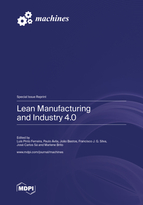Lean Manufacturing and Industry 4.0
A special issue of Machines (ISSN 2075-1702). This special issue belongs to the section "Industrial Systems".
Deadline for manuscript submissions: closed (28 February 2023) | Viewed by 35330
Special Issue Editors
Interests: lean manufacturing; manufacturing systems; discrete event simulation; simulation and optimization
Special Issues, Collections and Topics in MDPI journals
Interests: Innovation, sustainability; manufacturing and management; learning organization; organizational behaviour and development; virtualization
Interests: production planning; scheduling; meta-heurisitcs; machine learning Tools
Interests: tribology; coatings; manufacturing processes
Special Issues, Collections and Topics in MDPI journals
Interests: industrial management; lean; six-sigma; processes improvement; safety; sustainability
Special Issues, Collections and Topics in MDPI journals
Special Issue Information
Dear Colleagues,
The increasing application of innovative digital technologies has lead to a push for major changes in manufacturing during the era of Industry 4.0. As these changes coincide with the increasing demand for sustainability, there has been a strong case for the application of lean methodologies in all aspects of the manufacturing process. Lean manufacturing is a production method aimed primarily at reducing times within the production system as well as response times from suppliers and to customers. As the application of lean methods is quite broad, it has attracted much attention of many experts in the fields of manufacturing, supply chain management, production simulation, optimization, management and green technologies.
This Special Issue seeks original research papers focusing on advances in applications of lean manufacturing methodologies and Industry 4.0 technologies. We hope that this Special Issue will be useful and informative to both researchers and practitioners. We also hope to inspire readers with promising new ideas and directions for future research.
Prof. Dr. Luís Pinto Ferreira
Chief Guest Editor
Prof. Dr. Paulo Ávila
Prof. Dr. João Bastos
Prof. Dr. Francisco J. G. Silva
Prof. José Carlos Sá
Prof. Dr. Marlene Brito
co-Guest Editors
Manuscript Submission Information
Manuscripts should be submitted online at www.mdpi.com by registering and logging in to this website. Once you are registered, click here to go to the submission form. Manuscripts can be submitted until the deadline. All submissions that pass pre-check are peer-reviewed. Accepted papers will be published continuously in the journal (as soon as accepted) and will be listed together on the special issue website. Research articles, review articles as well as short communications are invited. For planned papers, a title and short abstract (about 100 words) can be sent to the Editorial Office for announcement on this website.
Submitted manuscripts should not have been published previously, nor be under consideration for publication elsewhere (except conference proceedings papers). All manuscripts are thoroughly refereed through a single-blind peer-review process. A guide for authors and other relevant information for submission of manuscripts is available on the Instructions for Authors page. Machines is an international peer-reviewed open access monthly journal published by MDPI.
Please visit the Instructions for Authors page before submitting a manuscript. The Article Processing Charge (APC) for publication in this open access journal is 2400 CHF (Swiss Francs). Submitted papers should be well formatted and use good English. Authors may use MDPI's English editing service prior to publication or during author revisions.
Keywords
- lean manufacturing
- lean optimization techniques
- sustainable manufacturing
- Industry 4.0
- digitalization









